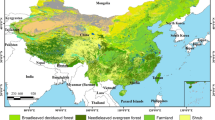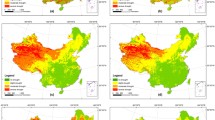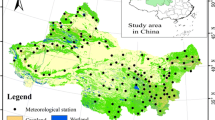Abstract
Drought is a type of natural disaster that has the most significant impacts on agriculture. Regional drought monitoring based on remote sensing has become popular due to the development of remote sensing technology. In this study, vegetation condition index (VCI) data recorded from 1982 to 2010 in agricultural areas of China were obtained from advanced very high resolution radiometer (AVHRR) data, and the temporal and spatial variations in each drought were analyzed. The relationships between drought and climate factors were also analyzed. The results showed that from 1982 to 2010, the agricultural areas that experienced frequent and severe droughts were mainly concentrated in the northwestern areas and Huang-Huai Plain. Moreover, the VCI increased in the majority of agricultural areas, indicating that the drought frequency decreased over time, and the decreasing trend in the southern region was more notable than that in the northern region. A correlation analysis showed that temperature and wind velocity were the main factors that influenced drought in the agricultural areas of China. From a regional perspective, excluding precipitation, the climate factors had various effects on drought in different regions. However, the correlation between the VCI and precipitation was low, possibly due to the widespread use of artificial irrigation technology, which reduces the reliance of agricultural areas on precipitation.






Similar content being viewed by others
References
Bajgiran, P., Darvishsefat, A. A., Khalili, A., & Makhdoum, M. F. (2008). Using AVHRR-based vegetation indices for drought monitoring in the northwest of Iran. Journal of Arid Environments, 72(6), 1086–1096. doi:10.1016/j.jaridenv.2007.12.004.
Bokal, S., Grobicki, A., Kindler, J., & Thalmeinerova, D. (2014). From national to regional plans—the integrated drought management Programme of the global water Partnership for Central and Eastern Europe. Weather and Climate Extremes, 3, 37–46. doi:10.1016/j.wace.2014.03.006.
Cai, B., Lu, W. J., & Zheng, X. J. (1995). Using meteorological satellite’s VCI to monitor soil state. Remote Sensing for Land & Resource, 4, 45–50.
Dai, A. (2013). Increasing drought under global warming in observations and models. Nature Climate Change, 3, 52–58.
Domenikiotis, C., Spiliotopoulos, M., Tsiros, E., & Dalezios, N. R. (2004). Early cotton yield assessment by the use of the NOAA/AVHRR derived vegetation condition index (VCI) in Greece. International Journal of Remote Sensing, 25(14), 2807–2819. doi:10.1080/01431160310001632729.
Dutta, D., Kundu, A., Patel, N. R., Saha, S. K., & Siddiqui, A. R. (2015). Assessment of agricultural drought in Rajasthan (India) using remote sensing derived vegetation condition index (VCI) and standardized precipitation index (SPI). Egyptian Journal of Remote Sensing and Space Science, 18(1), 53–63. doi:10.1016/j.ejrs.2015.03.006.
Field, C. B., Barros, V., Stocker, T. F., Qin, D., Dokken, D. J., Ebi, K. L., et al. (2012). Managing the risks of extreme events and disasters to advance climate change adaptation. A special report of working groups I and II of the intergovernmental panel on climate change. Cambridge: Cambridge University Press.
Guan, X. D., Guo, N., Huang, J. P., Ge, J. M., & Zhang, Z. H. (2008). Applicability analysis of VCI to monitoring northwest China drought. Plateau Meteorology, 27, 1046–1053.
Guo, N., & Wang, X. P. (2015). Advances and developing opportunities in remote sensing of drought. Journal of Arid Meteorology, 33, 1–18.
Hao, C., Zhang, J., & Yao, F. (2015). Combination of multi-sensor remote sensing data for drought monitoring over Southwest China. International Journal of Applied Earth Observation and Geoinformation, 35, 270–283. doi:10.1016/j.jag.2014.09.011.
He, J. Y., Zhang, M. J., Wang, P., Wang, S. J., & Wang, X. M. (2011). Climate characteristics of the extreme drought events in Southwest China during recent 50 years. Acta Geographica Sinca, 66, 1179–1190.
Jiao, W., Zhang, L., Chang, Q., Fu, D., Cen, Y., & Tong, Q. (2016). Evaluating an enhanced vegetation condition index (VCI) based on VIUPD for drought monitoring in the continental United States. Remote Sensing, 8(3), 224. doi:10.3390/rs8030224.
Kogan, F. N. (1995). Droughts of the late 1980s in the United States as derived from NOAA polar-orbiting satellite data. Bulletin of the American Meteorological Society, 76, 655–668. doi:10.1175/1520-0477(1995)076<0655:DOTLIT>2.0.CO;2.
Liang, L., Zhao, S., Qin, Z., He, K., Chen, C., Luo, Y., et al. (2014). Drought change trend using MODIS TVDI and its relationship with climate factors in China from 2001 to 2010. Journal of Integrative Agriculture, 13(7), 1501–1508. doi:10.1016/S2095-3119(14)60813-3.
Liu, W. T., & Kogan, F. N. (1996). Monitoring regional drought using the vegetation condition index. International Journal of Remote Sensing, 17(14), 2761–2782. doi:10.1080/01431169608949106.
Liu, L. W., Zhang, W. P., Duan, Y. H., Xing, L. X., Chen, X. B., & Zhao, M. (2014a). Terrain corrected TVDI for agricultural drought monitoring using MODIS data. Acta Geographica Sinca, 34, 3704–3711.
Liu, Z. J., Liu, J. Y., & Shao, Q. Q. (2014b). Optimum temperature of vegetation growth for various land cover types in China. Journal of Geo-Information Science, 16, 1–7.
Liu, X., Zhu, X., Pan, Y., Li, S., Liu, Y., & Ma, Y. (2016). Agricultural drought monitoring: progress, challenges, and prospects. Journal of Geographical Sciences, 26(6), 750–767. doi:10.1007/s11442-016-1297-9.
Ma, Z., & Fu, C. (2006). Some evidence of drying trend over northern China from 1951 to 2004. Chinese Science Bulletin, 51(23), 2913–2925. doi:10.1007/s11434-006-2159-0.
Mao, K., Qin, Z., Shi, J., & Gong, P. (2005). A practical split-window algorithm for retrieving land-surface temperature from MODIS data. International Journal of Remote Sensing, 26(15), 3181–3204. doi:10.1080/01431160500044713.
Mao, K. B., Shi, J. C., Li, Z. L., & Tang, H. J. (2007). An RM-NN algorithm for retrieving land surface temperature and emissivity from EOS/MODIS data. Journal of Geophysical Research: Atmospheres (1984–2012), 112, 1–17.
Masud, M. B., Khaliq, M. N., & Wheater, H. S. (2015). Analysis of meteorological droughts for the Saskatchewan River Basin using univariate and bivariate approaches. Journal of Hydrology, 522, 452–466. doi:10.1016/j.jhydrol.2014.12.058.
Ozelkan, E., Chen, G., & Ustundag, B. B. (2016). Multiscale object-based drought monitoring and comparison in rainfed and irrigated agriculture from Landsat 8 OLI imagery. International Journal of Applied Earth Observation and Geoinformation, 44, 159–170. doi:10.1016/j.jag.2015.08.003.
Quiring, S. M., & Ganesh, S. (2010). Evaluating the utility of the vegetation condition index (VCI) for monitoring meteorological drought in Texas. Agricultural and Forest Meteorology, 150(3), 330–339. doi:10.1016/j.agrformet.2009.11.015.
Rouse, J. W. J., Haas, R. H., Schell, J. A., & Deering, D. W. (1974). Monitoring vegetation systems in the Great Plains with ERTS. NASA Special Publication, 351, 309.
Sandholt, I., Rasmussen, K., & Andersen, J. (2002). A simple interpretation of the surface temperature/vegetation index space for assessment of surface moisture status. Remote Sensing of Environment, 79(2–3), 213–224. doi:10.1016/S0034-4257(01)00274-7.
Sha, S., Guo, N., Li, Y. H., Ren, Y. L., & Li, Y. P. (2013). Comparison of the vegetation condition index with meteorological drought indices: a case study in Henan province. Journal of Glaciology and Geocryology, 35, 990–998.
Wang, J. S., Li, Y. H., Wang, R. Y., Feng, J. Y., & Zhao, Y. X. (2012a). Preliminary analysis on the demand and review of progress in the field of meteorological drought research. Journal of Arid Meteorology, 30, 497–508.
Wang, Z. M., Yang, H. B., Ji, Q. C., & Li, X. T. (2012b). Remote sensing monitoring for drought in Henan province based on MODIS. Bulletin of Soil and Water Conservation, 32, 139–211.
Wilhite, D. A. (2000). Drought as a natural hazard: concepts and definitions. Drought a Global Assessment, 1, 3–18.
Yan, L. K. (2003). Application of correlation coefficient and biased correlation coefficient in related analysis. Journal of Yunnan University of Finance and Economics, 19, 78–80.
Yin, H., & Li, Y. H. (2013). Summary of advance on drought study in Southwest China. Journal of Arid Meteorology, 31, 182–193.
Zhang, Q., Zhang, L., Cui, X. C., & Zeng, J. (2011a). Progresses and challenges in drought assessment and monitoring. Progresses and Challenges in Drought Assessment and Monitoring, 26, 763–778.
Zhang, Y. D., Zhang, X. H., & Liu, S. R. (2011b). Correlation analysis on normalized difference vegetation index (NDVI) of different vegetations and climatic factors in Southwest China. Chinese Journal of Applied Ecology, 22(2), 323–330.
Zhao, Y. S. (2013). Analysis principle and method of remote sensing application. Beijing: Science Press.
Zhou, D., Zhang, B., Gui, R. P., Zhang, C. L., Yang, S. W., & Ji, D. M. (2014). Analysis of drought characteristics of Shaanxi province in recent 50 years based on standardized precipitation evapotranspiration index. Journal of Natural Resources, 29, 677–688.
Acknowledgments
This research is supported by the National Science Foundation of China (nos. 41401473 and 31560130); the Postdoctoral Science Foundation of China (2013M531329); the National Basic Research Program of China (no. 2010CB951503); and the National Innovation and Entrepreneurship Training Program for Undergraduates (nos. 201610320004Z and 201310320048Z).
Author information
Authors and Affiliations
Corresponding author
Electronic supplementary material
ESM 1
(PDF 907 kb)
Rights and permissions
About this article
Cite this article
Qian, X., Liang, L., Shen, Q. et al. Drought trends based on the VCI and its correlation with climate factors in the agricultural areas of China from 1982 to 2010. Environ Monit Assess 188, 639 (2016). https://doi.org/10.1007/s10661-016-5657-9
Received:
Accepted:
Published:
DOI: https://doi.org/10.1007/s10661-016-5657-9




